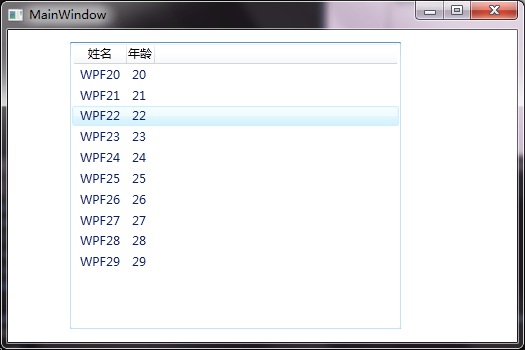一:控件到控件的绑定
1:OneWay
Source影响着Target,但是Target却影响不到Source。
2:OneWayToSource
Target影响Source,而Source却影响不到Target。
3:TwoWay
Source与Target相互影响。
4:OneTime
在OneWay的基础上延伸了一个OneTime,仅绑定一次。如果大家属性Jquery中的one函数我想就可以不用表述了。
<Window x:Class="WpfApplication1.Window1"
xmlns="http://schemas.microsoft.com/winfx/2006/xaml/presentation"
xmlns:x="http://schemas.microsoft.com/winfx/2006/xaml"
xmlns:sys="clr-namespace:System;assembly=mscorlib"
xmlns:src="clr-namespace:WpfApplication1"
Title="MainWindow" Height="350" Width="525">
<Canvas>
<ScrollBar Height="24" Name="scrollBar1" Width="237" Orientation="Horizontal" Canvas.Left="103" Canvas.Top="51" Minimum="1" Maximum="100" SmallChange="1" />
<Label Canvas.Left="41" Canvas.Top="121" Content="OneWay" Height="28" Name="label1" />
<TextBox Canvas.Left="165" Canvas.Top="121" Height="23"
Text="{Binding ElementName=scrollBar1, Path=Value, Mode=OneWay}"
Name="textBox1" Width="120" />
<Label Canvas.Left="41" Canvas.Top="160" Content="OneWayToSource" Height="28" Name="label2" />
<TextBox Canvas.Left="165" Canvas.Top="160" Height="23"
Text="{Binding ElementName=scrollBar1, Path=Value, Mode=OneWayToSource}"
Name="textBox2" Width="120" />
<Label Canvas.Left="41" Canvas.Top="202" Content="TwoWay" Height="28" Name="label3" />
<TextBox Canvas.Left="165" Canvas.Top="202" Height="23"
Text="{Binding ElementName=scrollBar1, Path=Value, Mode=TwoWay}"
Name="textBox3" Width="120" />
<Label Canvas.Left="41" Canvas.Top="231" Content="OneTime" Height="28" Name="label4" />
<TextBox Canvas.Left="165" Canvas.Top="231" Height="23"
Text="{Binding ElementName=scrollBar1, Path=Value, Mode=OneTime}"
Name="textBox4" Width="120" />
</Canvas>
</Window>

二:.net对象与控件的绑定
<Window x:Class="WpfApplication1.Window1"
xmlns="http://schemas.microsoft.com/winfx/2006/xaml/presentation"
xmlns:x="http://schemas.microsoft.com/winfx/2006/xaml"
xmlns:sys="clr-namespace:System;assembly=mscorlib"
xmlns:src="clr-namespace:WpfApplication1"
Title="MainWindow" Height="350" Width="525">
<Grid>
<ListView Height="287" HorizontalAlignment="Left" Margin="62,12,0,0" Name="listView1" VerticalAlignment="Top" Width="331">
<ListView.View>
<GridView>
<GridView.Columns>
<GridViewColumn Header="姓名" DisplayMemberBinding="{Binding Name}"/>
<GridViewColumn Header="年龄" DisplayMemberBinding="{Binding Age}"/>
</GridView.Columns>
</GridView>
</ListView.View>
</ListView>
</Grid>
</Window>

三:.net方法与控件的绑定( 在做wpf时,有时我们需要在xaml中绑定.net中的方法,当然这在实际开发中也是很常用的,不过方法必要由ObjectDataProvider来封装。)
<Window x:Class="WpfApplication1.Window1"
xmlns="http://schemas.microsoft.com/winfx/2006/xaml/presentation"
xmlns:x="http://schemas.microsoft.com/winfx/2006/xaml"
xmlns:sys="clr-namespace:System;assembly=mscorlib"
xmlns:local="clr-namespace:WpfApplication1"
Title="MainWindow" Height="350" Width="525">
<Window.Resources>
<ObjectDataProvider x:Key="Test" ObjectType="{x:Type local:Student}" MethodName="GetName">
</ObjectDataProvider>
</Window.Resources>
<Grid>
<TextBlock Text="{Binding Source={StaticResource ResourceKey=Test}, Mode=OneWay}"/>
</Grid>
</Window>
using System.Windows.Controls;
using System.Windows.Data;
using System.Windows.Documents;
using System.Windows.Input;
using System.Windows.Media;
using System.Windows.Media.Imaging;
using System.Windows.Shapes;
namespace WpfApplication1
{
/// <summary>
/// Window1.xaml 的交互逻辑
/// </summary>
public partial class Window1 : Window
{
public Window1()
{
InitializeComponent();
}
}
public class Student
{
//前台要引用的方法
public string GetName()
{
return "WPF";
}
}
}

四:wpf中的验证
<Window x:Class="WpfApplication1.Window1"
xmlns="http://schemas.microsoft.com/winfx/2006/xaml/presentation"
xmlns:x="http://schemas.microsoft.com/winfx/2006/xaml"
xmlns:sys="clr-namespace:System;assembly=mscorlib"
xmlns:local="clr-namespace:WpfApplication1"
Title="MainWindow" Height="350" Width="525">
<Window.Resources>
<local:Student x:Key="student"/>
</Window.Resources>
<Grid>
<TextBlock Height="23" HorizontalAlignment="Left" Margin="97,54,0,0" Name="textBlock1" Text="姓名" VerticalAlignment="Top" />
<TextBox DataContext="{StaticResource ResourceKey=student}" Height="23" HorizontalAlignment="Left" Margin="153,54,0,0" Name="textBox1" VerticalAlignment="Top" Width="120">
<TextBox.Text>
<Binding Path="Name" UpdateSourceTrigger="PropertyChanged">
<!-- 自定义的验证规格,当然可以是多个Check -->
<Binding.ValidationRules>
<local:NameCheck />
</Binding.ValidationRules>
</Binding>
</TextBox.Text>
<TextBox.ToolTip>
<!--将当前的错误信息显示在tooltip上-->
<Binding RelativeSource="{RelativeSource Self}" Path="(Validation.Errors)[0].ErrorContent"/>
</TextBox.ToolTip>
</TextBox>
</Grid>
</Window>
namespace WpfApplication1
{
/// <summary>
/// Window1.xaml 的交互逻辑
/// </summary>
public partial class Window1 : Window
{
public Window1()
{
InitializeComponent();
}
}
public class NameCheck : ValidationRule
{
public override ValidationResult Validate(object value, System.Globalization.CultureInfo cultureInfo)
{
var name = Convert.ToString(value);
//如果名字长度大于4则是非法
if (name.Length > 4)
return new ValidationResult(false, "名字长度不能大于4个长度!");
return ValidationResult.ValidResult;
}
}
public class Student
{
public string Name { get; set; }
public int Age { get; set; }
}
}
